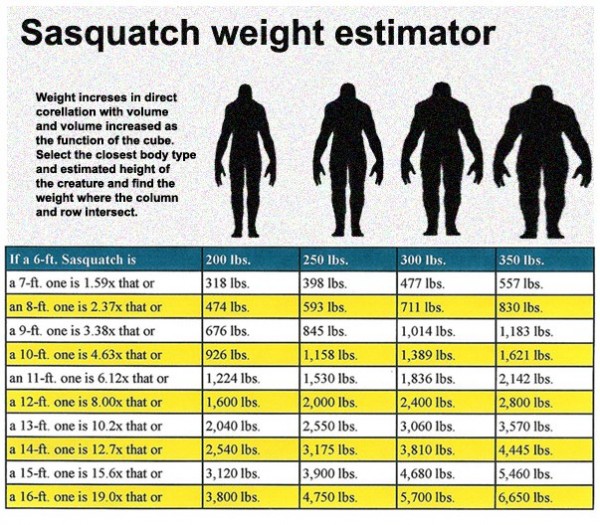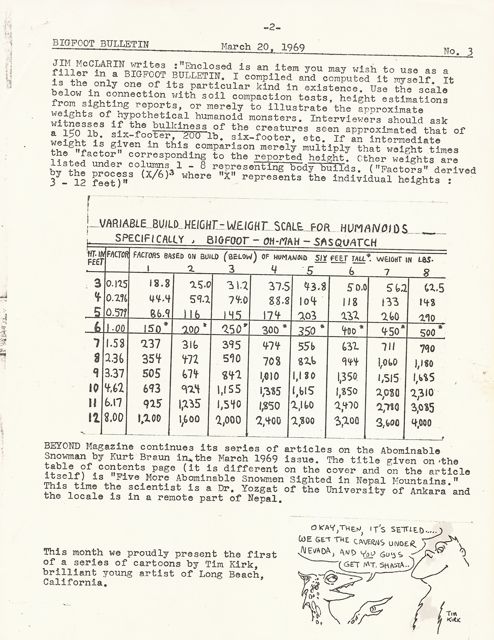Spring is right around the corner and more and more people will be getting out into nature. The bigfoots will be returning to there summer feeding grounds and some lucky hikers will be “bumping” into them. This naturally will lead to questions for those with stories to tell:
How big was it?
Were you scared?
Did it smell?
What were you drinking?
Can I have some?
Now there is a tool you can take along on your hike to answer at least one question about the bigfoot you saw.
Jim McClarin, Facebook Friend of Dr. Jeff Meldrum, has posted a useful field guide for estimating the weight of the bigfoot you saw.

I saw this chart and since no one I have ever heard of has weighed a bigfoot I had to ask:
“Can I ask why you created this chart, and what is your background or any expertise that you used, or did you just do some research and put this together?”
I was an early BF researcher for nine years, not that that in any way “qualifies” me, so I have had an interest and always felt people were underestimating the weight of the creatures they reported seeing. I had done a few weight projections based on the cubed value function but thought it would be nice to put a useful tool together that people could use without having to do any rudimentary math (or solve a dreaded word problem).
Someone had opined that the farther north you go, the bigger the Sasquatches are reported to be, all the way up to 16 feet. I can’t vouch for this but was nevertheless curious what a 16-ft creature would weigh, and that was the genesis of my table.I was asked in another group how I arrived at the coefficients in my table so I’ll add my answer here:
Since we only have height as a dimension in my table I used it to form my cube value. Of course you will never see a squatch 7’x7’x7′ but all we are after is a consistent value to compare in order to arrive at a coefficient for weight/volume. So I cubed each height on the table, then divided the value for a six-footer into the value for each of the other heights to arrive at my coefficient.
The result would be the same if we took a standard fraction of the cubed value that might more closely approximate the actual volume of the creature but it’s an unnecessary step to arrive at a coefficient. (By coincidence, because of the weight of a cubic foot of flesh, the height-cubed value is about the number of pounds a very skinny Sasquatch would weigh.)
My math:
6 cubed = 216 = 1.00×216
7 cubed = 343 = 1.59×216
8 cubed = 512 = 2.37×216
9 cubed = 729 = 3.38×216
10 cubed = 1,000 = 4.63×216
11 cubed = 1,331 = 6.16×216
12 cubed = 1,728 = 8.00×216
13 cubed = 2,197 = 10.2×216
14 cubed = 2,744 = 12.7×216
15 cubed = 3,375 = 15.6×216
16 cubed = 4,096 = 19.0×216I think the largest BF footprint cast is 22 inches. If we allow for two inches of foot length per foot of height (just a rough integer value), then that would correspond to an 11-foot Sasquatch.
This is not the first time Jim has put together a reference chart. He sent me this one from 1969:

The skinny end of the table could also be used by those researching ancient human giant skeletal remains, so many of which were reported unearthed in the past couple centuries but received the official HUSH treatment by the Smithsonian after they commandeered the specimens.
So there you have it, a handy tool to take along on your hikes during the upcoming fine spring weather. Now if this could just be converted to an App for your Iphone or Android…
And don’t forget to LIKE us on Our FaceBook Page
9 comments




